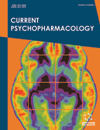- Home
- A-Z Publications
- Current Psychopharmacology
- Previous Issues
- Volume 6, Issue 1, 2017
Current Psychopharmacology - Volume 6, Issue 1, 2017
Volume 6, Issue 1, 2017
-
-
Pharmacological Functional MRI in Rodent Model
More LessThe pharmacological effects on the brain will occur widely in whole brain. Therefore, pharmacological functional MRI (fMRI) is a promising non-invasive tool to investigate the whole brain activation following pharmacological stimulation. The multimodal fMRI techniques, which reflect the vascular response (blood oxygenation level dependent fMRI), neuron/astrocyte activity (diffusion fMRI) and Ca2+ influx in excitatory neu Read More
-
-
-
Psychiatric Polypharmacy, Etiology and Potential Consequences
More LessPsychiatric polypharmacy is defined as the use of two or more drugs in the treatment of a psychiatric condition. It is widely prevalent in clinical practice. The rationale for polypharmacy is not clear. Etiologic factors are patient demographics (age, gender, race, low socioeconomic status), personality disorder, psychiatric conditions (psychosis, schizophrenia, affective or mood disorders), comorbidities, severity of disease, tr Read More
-
-
-
Influence of Cholinesterase Inhibitor on Clinical Symptoms of Schizophrenia
More LessAuthors: Saeed S. Shafti and Abbas A. KhoeiObjective: Problem with memory and attention is a neglected aspect of schizophrenia. The most affected domains are attention, working memory and semantic memory. The impairments are, like the negative symptoms, basically stable and independent of the positive symptoms. Since such deficits do not respond to antipsychotics, during the past years some approaches have been done by different acetylcholinesterase inhib Read More
-
-
-
Intramuscular Route of Administration Increases Potency in Eliciting Cocaine-Induced Behavioral Sensitization
More LessAuthors: Beth A. Rice, Raza Tariq and Chana K. AkinsBackground: Cocaine is the number one abused psychostimulant drug that reaches addiction criterion in the US. In animals, repeated administration of cocaine results in behavioral sensitization which is thought to represent adaptations in the mesolimbic dopamine neural circuitry, the reward pathway. Cocaine-induced behavioral sensitization is evident in rodents and quail when cocaine is administered intraperitone Read More
-
-
-
Safety with Zopiclone Use: Contemporary Issues
More LessBackground: The safety of zopiclone and other Z-drug use has been questioned in many regards. Past issues of side effects, tolerance, abuse, addition, and inappropriate uses have all deserved attention. Objective: In this paper, the issue of zopiclone safety is again reviewed for information newly arising over the last decade. Method: Information databases were scanned for ‘zopiclone’, and all relevant literature was reviewe Read More
-
-
-
Self-Reported Physical, Affective and Somatic Effects of Ecstasy (MDMA): An Observational Study of Recreational Users
More LessBackground: Assessments of the residual effects of 3,4-methylenedioxymethamphetamine (MDMA) are typically restricted to experimental studies. The current observational study aimed to investigate the immediate and delayed cognitive, affective and somatic effects of recreational MDMA and other drug use among adults. Method: Thirty-eight adults (26 males and 12 females) aged 19-55 years (mean age 32.1 years) who atten Read More
-
-
-
Colon Targeted Pulsatile Drug Delivery System of Venlafaxine Hydrochloride for Treatment of Depression
More LessAuthors: Ajay Kumar, Ankaj Kaundal, Mahendra S. Ashawat, Vinay Pandit and Pravin KumarObjective: In the current research study, a colon targeted pulsatile drug delivery system (PDDS) of venlafaxine hydrochloride (VH) was designed for chronotherapy of depression. Method: A capsular device was designed having body insoluble throughout gastrointestinal tract (GIT) fluid and cap soluble in small intestine fluid. The granules of VH was filled in the body and separated from the cap with the help of a hydrophilic polym Read More
-
-
-
Serotonergic and Behavioral Responses to Stress with Tryptophan in Rats
More LessAuthors: Sumera Gul, Darakhshan J. Haleem, Sabira Naqvi, Shazia Nawaz, Tabinda Salman, Qurrat-ul-aen Inam and Ahsana DarBackground: Recent studies show that together with serotonin (5-hydroxytryptamine; 5-HT), leptin also plays an important role in the etiology of depression. Tryptophan increases brain 5-HT but the effects of tryptophan on leptin and responses to stress are not known. Objective: To evaluate the effect of tryptophan load (300mg/kg, orally) on serotonin metabolism, circulating levels of leptin and behavioral responses to single ( Read More
-
Most Read This Month
Article
content/journals/cpsp
Journal
10
5
false
en


